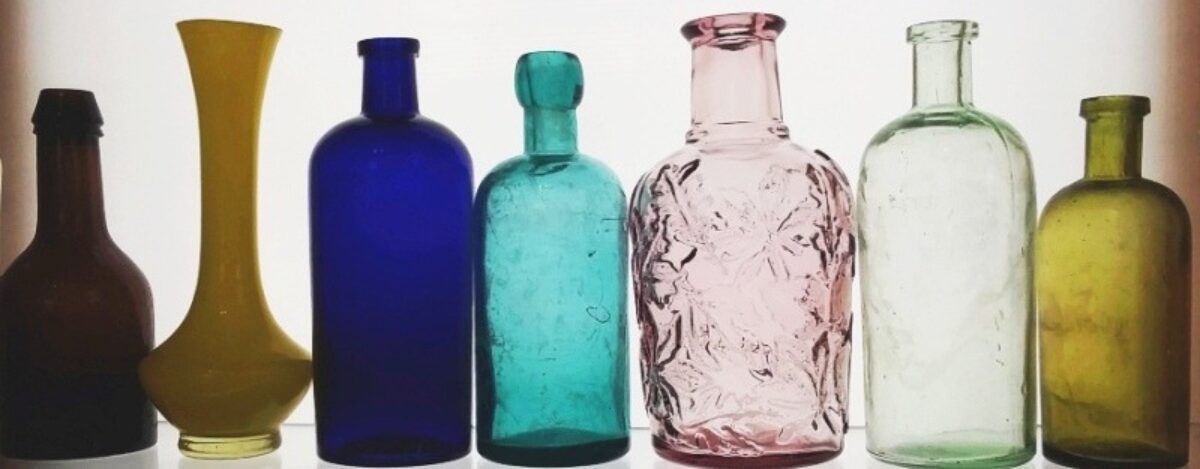“BALL PERFECT MASON” FRUIT JARS
The Ball Perfect Mason was a brand of glass fruit jar (canning jar) made by the Ball Bros. Glass Manufacturing Company. Ball Bros was based in Muncie, Indiana. (See Ball Brothers Glass Manufacturing Company page, for a brief summary of that glass company). The BPM was the most popular brand of jar for home canning ever produced in the United States. Hundreds of millions (probably well over a billion) were made, and these jars were used by home canners throughout much of the 20th century.
Ball Brothers also made many other styles of fruit jars, such as those marked “BALL IMPROVED”, “BALL IDEAL”, “BALL MASON”, “BALL SPECIAL”, “BALL SURE SEAL” and their “BALL STANDARD” (a type known as a “wax sealer” jar). Those other types of Ball jars are not discussed here as they deserve in-depth articles of their own.
In general, most fruit jars in aqua or “Ball Blue” glass marked “Ball Mason” date from before the introduction of the Ball Perfect Mason. (Clear jars marked “Ball Mason” were made in the 1960s and 1970s).
(IMPORTANT NOTE – MODERN REPRODUCTION ISSUE JARS: please see the paragraphs with info farther down on this page describing modern repro / reproductions of this jar, including the “AMERICAN HERITAGE COLLECTION” introduced in 2013, and the new “Collectors Edition” BALL PERFECT MASON jars being sold as of 2019).
The Ball Perfect Mason jars are commonly seen for sale on the secondary market at antique malls, farm and estate auctions, flea markets, thrift stores, rummage sales, yard/ garage sales, and on online auction sites such as eBay, etsy and other sites.
The very first jars marked “BALL PERFECT MASON” are believed to date from approximately 1913, with production continuing to about 1960. Many slight variations in lettering style, glass color, base markings, etc., exist, and this particular type of jar presents a wide field of study for fruit jar collectors, glass historians and even those interested in vintage Americana in general. Typically, most of the Ball Perfect Mason jars were made in half pint, pint, quart, and half-gallon sizes. Several “off-sizes” were also produced, although in much smaller quantities.
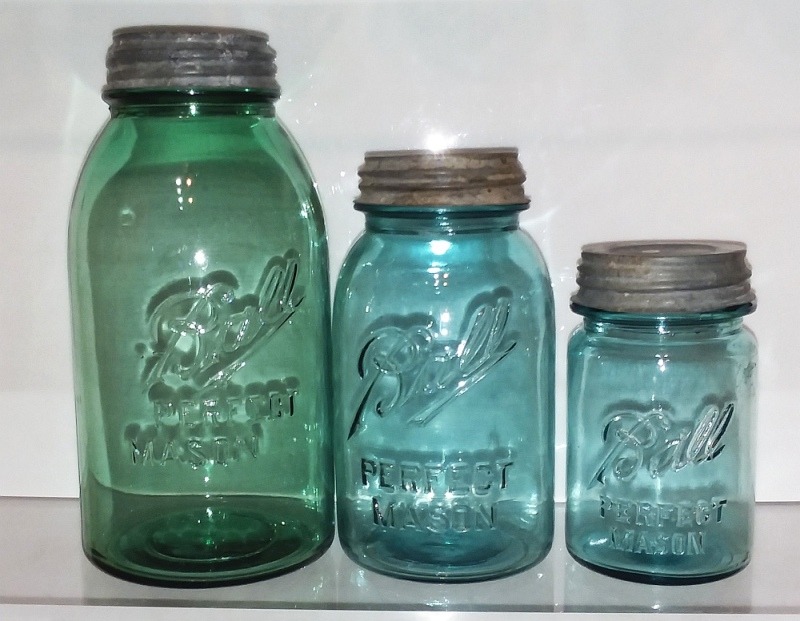
Most of the earlier versions were round (cylindrical) in shape, and some of the later types are square (with rounded corners) in design. Some variants have eight vertical raised bars or lines (“grips” or “grip bars”) along the sides, added to assist in handling the jars while they are wet. The jars with grips were introduced in about 1933. (Any Ball Perfect Mason jars in aqua or Ball Blue with the grip bars date between c.1933 and 1937).
Molds
Ball Perfect Mason jars were made entirely on automatic jar blowing machines. Each machine in the factory had a number of identical molds installed on them, and so very large quantities of jars could be produced in a fairly short period of time. Many different jar molds (thousands) were used over the many years’ time these jars were being produced.
Each mold was hand-cut (hand-engraved) with the lettering incised backward into the inside surface of the mold, which of course resulted in the embossing (raised lettering) which is seen on the surface of the jar. Very close inspection and comparison between different older jars (that may appear to be exactly the same) will show that it was very difficult, if not nearly impossible for all of the lettering (including the cursive “Ball” lettering and the “block style” lettering underneath) to be engraved absolutely identical from one mold to the next. Many slight variations are seen, with the exact lettering orientation just barely noticeably different from one example to another, such as the spacing, height, width and depth of cut of individual letters. Also, there were a number of variations in the way the Ball name logo was written, those changes occurring several times over the space of several decades. (See the chart farther down on this page).
ADVERTISEMENT
Most of the typical earlier Ball Perfect Mason jars in aqua or Ball Blue are marked with a mold number between 0 and 15 on the bottom. On some jar variants, (such as the first BALL embossing variant on these jars, “Logo 5” in chart shown below, used circa 1913-1923 on BPM jars), the number may be accompanied by a letter to the right, such as A or C.
Usually, the automatic jar-making machine had eight or ten mold cavities or “positions” for the molds. Thus, the single-digit numbered jars are more commonly found. A set of molds included numbers above “10” as the higher-numbered molds were typically used as replacements on the machine.
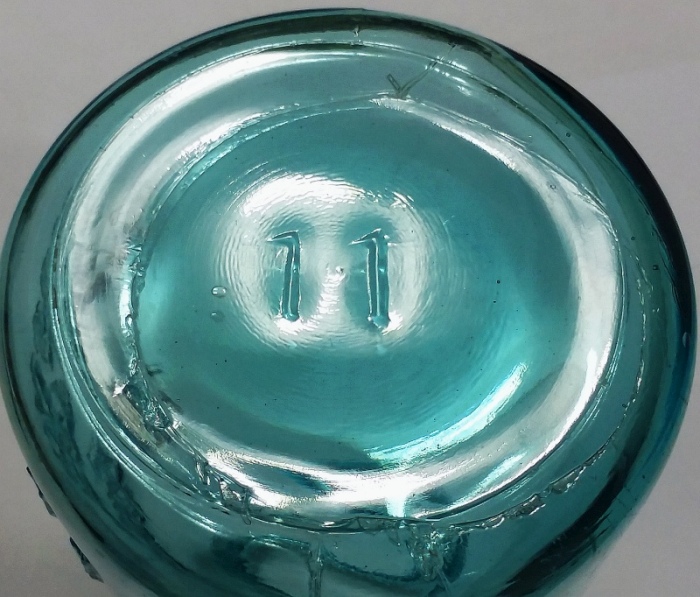
As can be readily discovered, there were many different “sets” of molds used over a period of many years, with this same series of (up to) 16 numbers used over and over again to identify the molds being used on a particular machine. The embossed numbers may vary considerably in size, shape and “style”. Some numbers are actually quite ornate or “stylized” and others are rather plain and ordinary! Since the numbers were engraved backward into the mold by hand, there is often some noticeable crudity to their styling.
Some jar collectors (and others who are not strictly jar collectors) may search for one example of each number between “0” and “15” – in order to assemble a “16 jar set” for use as kitchen canisters, storage jars, etc. The mold numbers from 11 through 15 seem to be the hardest to find. (See my paragraph farther down on this page about the “Number 13” BPM jars).
Underlined Mold Numbers
Some Ball Perfect Mason jars bear mold numbers with a line or underscore placed underneath the number. Although it seems the purpose of the underline would be to differentiate between a “9” and a “6”, that can’t be the real reason for all such underlines, since all of the numbers up to and including “10” are also found with an underline. I’m not sure why this was done, but my “pet theory” is that underlines were added to some jar mold sets merely to identify and differentiate the molds of that set from the molds of another set (without underlines) when both sets were in simultaneous use at the factory.
Incidentally, the digits “9” and “6” can usually be distinguished even without an underscore: the “9” (with some exceptions) typically has a gently curving downward stroke or “tail” that tends to be fairly vertical and does not curve around completely to form a “hook”. In contrast, the “6” will usually (but not always) feature a final stroke that does curve around as a “hook”, creating a character approaching the appearance of the lower case letter “g”.
Some mold numbers were engraved so they appear backward on the jar, such as the “backward 4” shown in the photo below. This error was actually caused by the mold maker engraving the number “4” correctly into the inside surface of the mold. (In order for the number to appear correctly on the finished jar, it must be engraved backward into the mold). Some jars have been found with “01” “41” and “51” which are assumed to be merely variants of “10”, “14” and “15”. There are probably others out there to be found! Some of the backward numbers might have been engraved into the mold purposely, simply to make the mold more easily identifiable and to differentiate from similar molds also in use at the time. An example shown here is a “backward 9” mold.
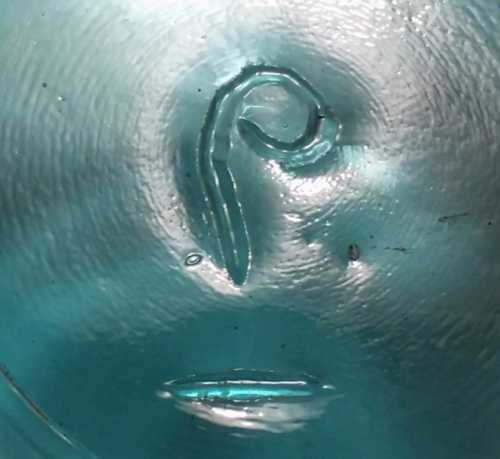
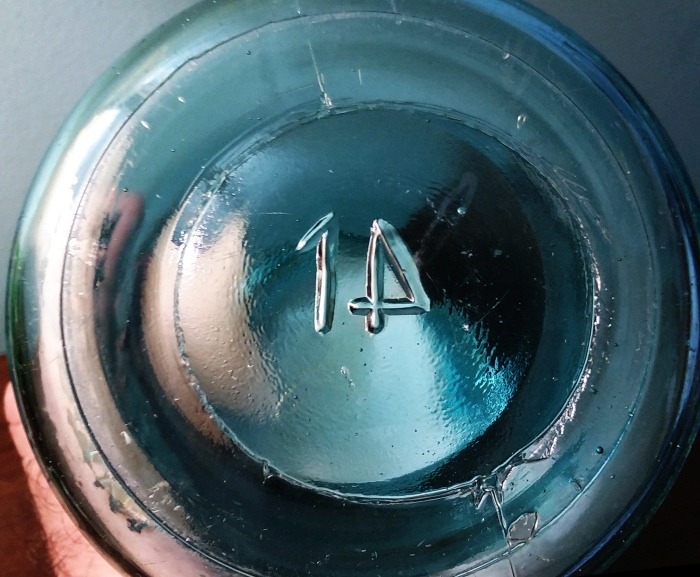
If a random sampling of these jars are studied (for instance, just looking at a selection of only those marked with a number “2” on the bottom), it may be seen that the numbers typically appears slightly different, in fact “unique” in their exact appearance, from one jar to the next. It may take a while before exact duplicates are found – that is, finding two jars that were both made from one individual, specific mold.
This is one of the aspects of collecting these jars that can be fun and intriguing (or boring to some!) if you are “into” studying fine differences in these jars – somewhat akin to the practice of collecting coins and comparing their minor “mold” or “die” variations.
Off-Sizes
Note: for a bit of information about the “off-size” BALL PERFECT MASON jars that are occasionally found, please check the COMMENTS section farther down on this page, and read the queries from Lee and Michelle, posted November / December of 2015. Thank you!
Glass Colors
The great majority of the BPM jars were made in bluish-aqua or “Ball Blue” colored glass. (Ball Blue is the standard color of these jars, a somewhat “more blue” shade of aqua). Later versions, after 1937, were usually made in clear (colorless) glass, and some (usually from the 1950s) in brown amber.
Other colors are known, but not so easily found, including cornflower blue, straw yellow, olive green, olive amber, blackish olive, dark yellow amber, light green and medium green. Some of these colors might be known under other/different names – depending on who is describing them! There are various shades and tints of these colors out there. If you have the opportunity, you might try attending an antique fruit jar and/or bottle show, where some of these unusually colored jars may show up for sale or in displays.
Fake REPRODUCTION / REPRO Ball Perfect Mason HALF-PINT size jars in Ball Blue – these can be very deceptive!
(This section was added June 16, 2021 – Some info below is courtesy of Linda White, one of the administrators of the Reproduction Fruit Jars discussion group on Facebook. Thanks, Linda!).
Although the original pint, quart and half gallon BALL PERFECT MASON jars in aqua or Ball Blue glass are very common and easily found, the original, authentic older HALF PINT size is considered to be quite scarce and difficult to find. Unfortunately, several years ago a number of newly made repro jars of this type and size began to surface in the United States. This may have first shown up around the year 2010 or thereabouts. These reproduction (fake) versions were NOT made or sold as official BALL products in regular retail outlets, unlike the modern reissues made by Ardagh Group that I discuss elsewhere on this page. These reproduction jars appear to have been produced in a concerted effort to mimic the look of the original c.1913-1923 half-pint jars, and were presumably made in an effort to capitalize on the scarcity of the older ones, and thus deceive jar collectors into believing they were old and authentic. They are believed to be imports – probably from somewhere in Asia – possibly India or China.
There are several minor differences that should be noted carefully as these reproductions can be hard to spot and they look very similar at a quick glance:
1) Although there is a mold number on the bottom (similar in “look” to the mold numbers on the originals) there is no Owens Scar on the new jars. The Owens scar was formed as part of the manufacturing process, and is a somewhat variable but generally rounded scar consisting of a thin, sharp, clearly defined “seam” or “line” that encircles part of the bottom. The seam may be somewhat “feathered” or “frayed” along the edge. The Owens scar is always present and virtually diagnostic on the original authentic jars. Instead, the base of the new jars is relatively smooth although there may be a faint, poorly defined mold seam.
2) The newer jars (not always, but usually) tend to have a considerable number of micro-bubbles scattered through the glass, which is not seen in the old jars. The old jars might have a few isolated bubbles, but not lots of tiny bubbles throughout all of the glass. The bubbly appearance of the glass is reminiscent of some glass decor items that have been imported to the US from such countries as Mexico, Spain and China. No one seems to know where these repro half-pints were made, but it is assumed they were made outside the US, possibly in China or India.
3) The weight of the new jars is very close to that of the old jars, but in many cases the newer jars are just slightly lighter in weight.
4) The “BALL PERFECT MASON” lettering is somewhat weaker and more “sloppy” or “smeared” in presentation, especially noticeable when comparing the new and old side-by-side.
5) There is virtually no base wear, nor any light scratching on the surface of the glass which would normally be seen (at least slightly) on most old jars (although base wear can be faked).
6) The glass looks shiny and “new”.
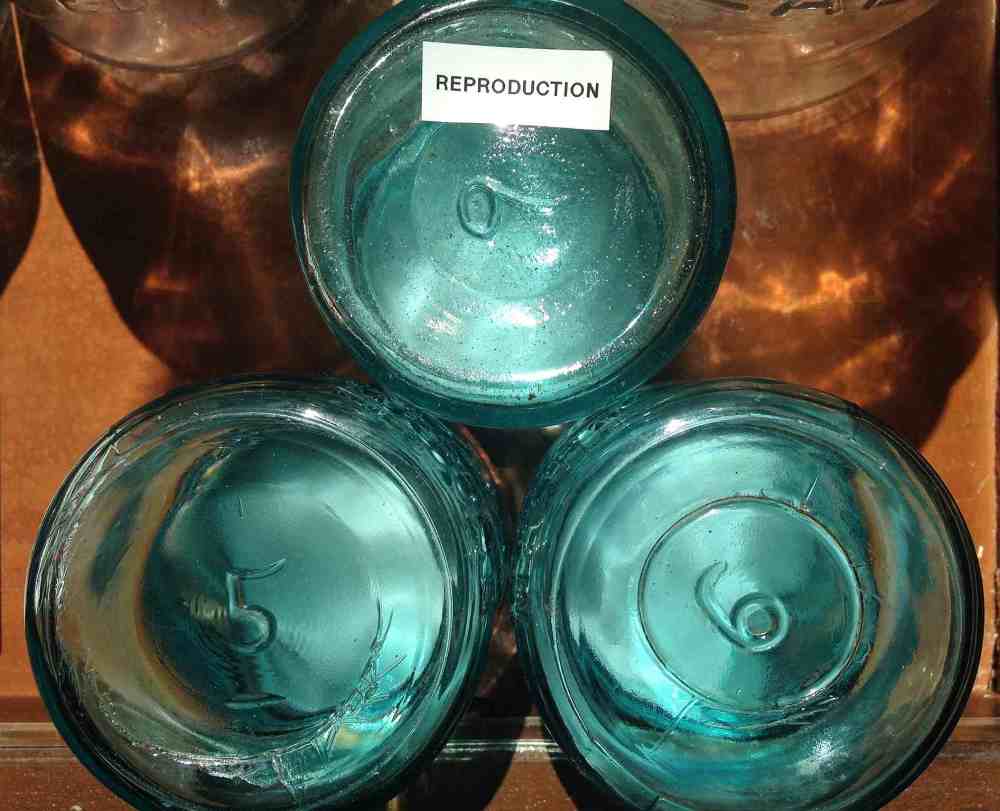
Here is a link to a discussion of these jars on the “Reproductions Fruit Jar Page” on Facebook:
Ball Half Pint Repro Jars – Discussion on Facebook
Error Jars
A number of “error jars” are found among the Ball Perfect Masons, including examples found with the embossing missing a letter (or letters), or with a word misspelled, such as “PERFFCT”, “PEPRECT” or “PEREFCT”.
A listing of many of the Ball Perfect Mason jar variations, including error jars, can be found in the “Red Book”, a price guide used by fruit jar collectors. In general, Ball Perfect Mason variants are listed in the Red Book from #270 to #295-6. (I am using the No. 11 edition. Older editions of the Red Book have different numbers assigned to the jars, in the 300 range). There are no doubt minor variants/errors that are not currently listed in that guide.
Some jars have embossing that is unusually faint (sometimes, all of the embossing, or just one or two letters within a word) and this can be due to accumulated debris (such as remnants of accumulated mold paste) having partially filled the engraving of the lettering on the mold at the time the jar was produced.
ADVERTISEMENT
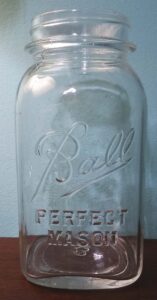
Number “13” Jars
Some Ball Perfect Mason jars are found with the number “13” on the bottom. As mentioned earlier in this article, most Ball Perfect Mason jars are typically found with a mold number ranging between 0 and 15, so naturally some percentage of them will carry the number “13”. Rumors have circulated for years (and have especially been promoted on auction sites and by flea market and antique mall dealers) that superstitious distillers of illegal whiskey (“moonshiners”) were hesitant to use jars marked with a 13 on the bottom. According to the stories, they threw them away, or intentionally broke them, fearing their enterprise could otherwise be met with bad luck. Sometimes the story accuses ordinary housewives of having done the same thing if they were especially superstitious.
Personally, I think most of the stories are hogwash, although I wouldn’t doubt that it happened on a very occasional basis, and just often enough to provide impetus for an urban legend (rural legend?). Most myths and legends are based on a kernel of truth, and this may be no exception to the rule. (However, keep in mind that fruit jars cost money, and the average farmer or housewife, often continually stretched to the limit with their household budget, would have never destroyed a jar merely because of the number on the bottom). Most home canners would have paid little or no attention to the markings in the first place.
Some dedicated and experienced antique jar collectors will say they think the number 13 jars are just as common as jars as those with other numbers. I don’t think this is true. There is a definitely noticeable difference in the numbers of #13-marked jars compared to the other numbers — they ARE somewhat less common. I’ve noticed this through looking at the bases of hundreds if not thousands of typical Ball Perfect Mason jars while browsing at antique and collectible malls and flea markets over the last 30+ years. However, the mild scarcity, in my opinion is NOT REALLY STRONG ENOUGH to warrant the high prices which are often asked for these jars on online auction sites. Of course, value is a very subjective thing and many collectors may not agree with my opinion on this subject.
Also, it seems evident that the mold numbers 11 through 15 are ALL somewhat scarcer than mold numbers 0 through 10. This is presumably because fewer molds were produced with the mold numbers 11 through 15 — thus fewer total jars made. I believe that many if not most of those higher-numbered molds were used as replacement molds on the jar blowing machines.
It seems evident that many of these jars are now saved by non-collectors or casual glass collectors (and “culled” from large groups of common jars) merely because of the number on the base. This “culling out” of #13 jars from among the “general population” of jars (and stashing them away) has certainly increased the perception of their scarcity. And the perception of relative scarcity can be enough to increase demand – and the demand for an item can then cause an increase in prices and perceived “value” – the old concept of “Supply and Demand” comes into play here.
They usually do sell on auction sites (if priced low enough) for several reasons- but typically because of the belief in the rumors, along with the general public’s fascination with the number 13 and its connection with the “dark side” of life, the theme of “being unlucky”, and the perceived connections with the supernatural, the occult, etc.
ADVERTISEMENT
New “REPRODUCTION” Ball Perfect Mason Jars: the “AMERICAN HERITAGE COLLECTION”
NOTE: In recent years (beginning circa 2013) a new type of BALL PERFECT MASON jar has been issued, primarily sold through department/grocery stores such as Walmart, Target, Kroger, and others, and online venues such as Amazon. These commemorative jars are being produced in a lighter, brighter blue color— not quite the same shade as the original jars.
These jars as being sold in sets of 6, and come in pint size only (as of this writing). They are marked (on front) “BALL PERFECT MASON”, on rear “1913 1915 / 100 YEARS OF / AMERICAN / HERITAGE / MADE IN U.S.A.” . Also, there are volume/weight measurements embossed along the side of the jar, including cups, milliliters and ounces. They are being sold along with modern screw bands and lids. The glass is a bit thinner and lighter than the original Ball Perfect Mason types.
(NOTE: in 2014, medium green glass quart size jars were issued, commemorating the 100th anniversary of the “PERFECTION” jars (introduced in 1914)…….the word “PERFECTION” is embossed underneath the cursive BALL. A third color (purple) was issued in 2015 for the 100th anniversary of their “Ball IMPROVED” jars (1915), and is embossed “IMPROVED” underneath the name “BALL”. The purple jars are made in pint and quart sizes).

These jars are being sold for actual canning use, but also for “rustic” or “retro” decorative appeal; are being used as containers for liquid soap dispensers (some ebay or etsy sellers are selling them with special lids for this use); for use in candle making, and for similar Americana “primitive” and crafts projects. Not to mention their appeal as a collector’s item which is virtually guaranteed because of the great popularity of the older jars .
The “1913 1915” embossing (given above) readily identifies these as new production. As time goes on, however, their provenance might be somewhat less obvious to beginning fruit jar collectors.
According to the Ardagh Group website, they are made by that glass manufacturing company for distributor Jarden Home Brands.
ADVERTISEMENT
NOTE: NEW “BALL PERFECT MASON” JARS BEING MADE IN 2019
(This paragraph added April 12, 2019).
New “Collectors’ Edition” BALL PERFECT MASON jars (with the cursive font style used in the 1910-1923 period) have appeared in grocery stores and department stores recently. They are sold through Hearthmark (Jarden’s Home Brands). As of the time of this writing, I have examined some PINT size jars, but I don’t know if they are (or will be) producing quart and/or half-gallon sizes. They are being sold in packs of four. There are a few differences between the new ones and the old originals which can be easily seen. (They are the same, typical “Ball Blue” or blueish-aqua color seen in most of the originals.) There is a small “circled R” underneath the “BALL” logo on the front of the new jars. The reverse side of the new jar bears the embossed phrase “MADE IN U S A”, and below that, along the “heel” of the jar, is a series of raised dots. The base carries a mold number along with the glass manufacturer’s mark used by Ardagh Group, the maker of the jars. This mark may be faint, and resembles a horseshoe or odd letter “U”. (See this mark illustrated in the “U” listings of he alphabetical bottle mark listings on this site). There is stippling or knurling (a pattern of raised dots) present along the contact surface/perimeter of the base. The new pint jars appear to be very slightly lighter in weight than the older ones, but this may not hold true on all jars, since there was some variability in the older jars. Out of curiosity, I weighed a new jar and old one, and the new jar weighed 10.375 ounces, the old jar weighing 10.75 ounces.
UPDATE 5/20/2021: Just a note that there are also new BALL PERFECT MASON jars in both the quart and half-pint (8 ounce) sizes available. The markings and characteristics are similar to the Pint size jars described above. At the present time (2021) I haven’t seen any in Half-Gallon size, although perhaps they will eventually be made in that size as well.
NOTE: Ardagh Group – North America is currently (2024) the owner of most of the former Ball Bros Glass Company plants . (Ball Bros>>>> Saint-Gobain Containers>>>>> Verallia>>>>> and now Ardagh Group. )
The Ardagh plant at Winchester, Indiana (where many of the new “Ball” brand jars are being made) is a former Anchor Glass Container Corporation facility that was acquired by Ardagh.
RESOURCES
For a detailed, comprehensive article with tons of background info on the Ball Brothers Glass Manufacturing Company, written by author/researcher Bill Lockhart (with input from several other collectors/researchers), check out his article ~ (This article also includes an expanded chart of BALL logo variations and estimated date ranges used over the years, as compiled by jar researcher Vivian “Granny” Kath). Click here: Ball Brothers Glass Manufacturing Company
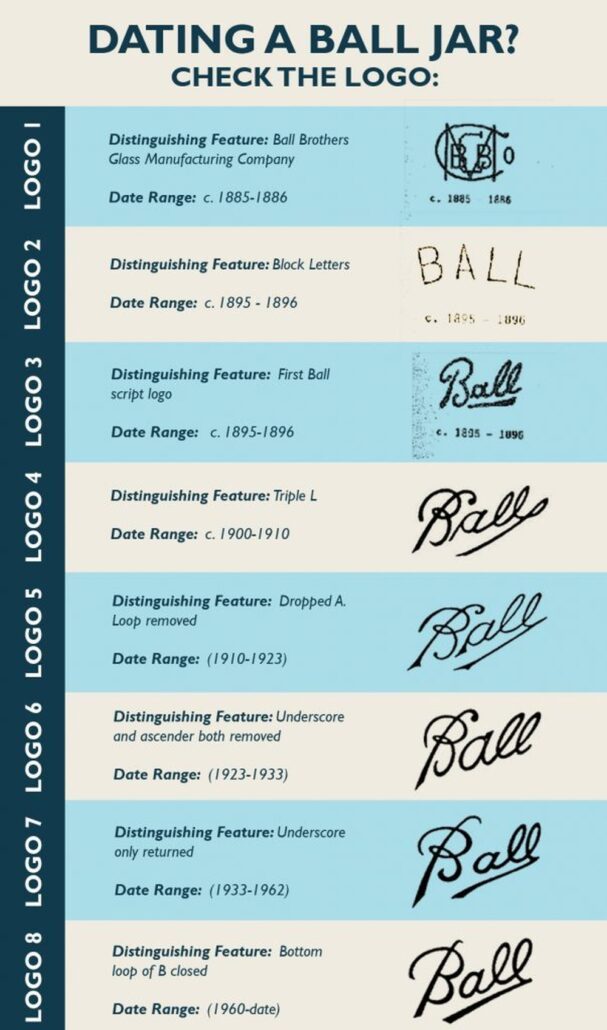
The “How to Date a Ball Jar” article written by Karen M. Vincent is currently at this URL:
https://www.minnetrista.net/blog/blog/2013/06/27/ball-family-history/how-to-date-a-ball-jar
Bob Clay’s article with a timeline on “How to Date Ball Fruit Jars” appears here near the bottom of this page:
http://www.weststpaulantiques.com/galleryofjars.html
General discussion forum for Ball fruit jar collectors: https://www.tapatalk.com/groups/balljarcollectorscommunitycenter/
“Ball Jar Collectors” discussion group on Facebook (this is a private group and requires an OK by the moderators before posting). There are over 10 thousand members so far:
Ball jar Collectors on Facebook
For information on values, you might check out the Redbookjars.com site, where the “Red Book” fruit jar price guide for collectors is available for purchase. (I’ve been told that the current edition is sold out, but a NEW updated edition is scheduled to be released in January of 2023!)
Interesting overview article posted on the Ball.com site:
Ball History and Timeline
Basic article about antique fruit jars, written by Dave Hinson
Here is a very good, basic yet rather comprehensive “Question and Answers” article with lots of general information about collectible fruit jars, written by jar collector and researcher Dave Hinson. This covers info on many brands of fruit jars besides Ball. (The original URL of this article seems to be “dead” but I’ve found an archived version of the webpage at the “Wayback Machine” internet archive, and it can be accessed at this web address: Fruit Jars – Questions and Answers – Dave Hinson
Please click here to go to my alphabetical mark listings, starting with “page one”: Glass Bottle Marks .
Click here to go to my website HOME / WELCOME PAGE.
Two other major types of antique fruit jars that are frequently encountered by collectors include the MASON’S PATENT NOV 30TH 1858 type jars and the WAX SEALER type jars.
ADVERTISEMENT

